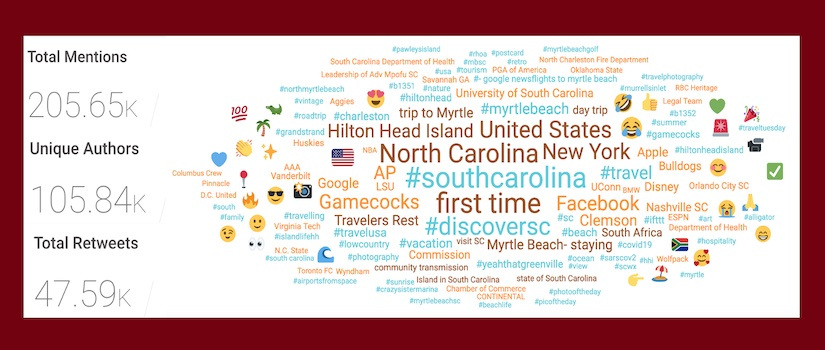The recovery of the South Carolina tourism industry from the impact of the coronavirus is the result, in large part, of the popularity of its beaches and destinations like Charleston, Myrtle Beach and Hilton Head, according to a new analysis by the Social Media Insights Lab at the University of South Carolina.
Tourism, which according to the S.C. Department of Parks, Recreation and Tourism generated $24.4 billion in 2019, took a big hit in 2020 because of the coronavirus, dropping to an estimated $16.2 billion. Revenue has rebounded in 2021, and PRT’s forecasts for next year show continued progress.
To better understand attitudes surrounding what is driving tourism in South Carolina, the Insights Lab reviewed more than 200,000 relevant mentions made online between Jan. 1 and Nov. 30, 2021, in news reports, reviews, blogs and forums as well as on social media platforms. The largest number of posts (52 percent) came from Twitter.
Comments cover a wide range of topics and offer significant insights into the popularity of South Carolina as a tourist destination. South Carolina’s beaches are world famous, so it is not surprising beaches are South Carolina’s most-discussed vacation activity.
The Insights Lab looked at conversations about 12 beaches ranked by U.S. News & World Report as the best in the state.
Myrtle Beach topped the list with more than 45,000 mentions, more than double the combined total for the other 11 beaches. That’s to be expected, though, since Myrtle Beach is the most-discussed tourist destination in South Carolina.
“About one-fourth of all South Carolina tourism conversations talk about Myrtle Beach,” said Insights Lab analyst Karena Abrams. “Myrtle Beach is seen nationally as one of the top vacation spots not just in South Carolina, but in the country.”
What do people like about Myrtle Beach? Not surprisingly, beaches top the list followed by golf, fishing and boating.
Following Myrtle Beach, Charleston was the second most-discussed South Carolina tourist destination and then Hilton Head. All three are along the coast, but each has its own appeal.
A key takeaway from this study is the significance of golf to South Carolina tourism. “We had three PGA golf tournaments in South Carolina in 2021, and they attracted a lot of attention, especially the PGA Championship at Kiawah,” Abrams said.
Golf is just one attribute of the Charleston area. Online conversations also talked about its beaches, boating and fishing as well as what could be described as cultural tourism, which includes interest in historic sites such as plantations and the slave market.
The Insights Lab looked at cultural tourism from a statewide perspective and found that it is a growing and popular trend. For example, there is considerable interest in the Civil War and life in the South during that era. Many took to social media to argue it is important to learn from the past. Others, though, were critical of the commercialization of plantations and other slavery-era sites.
A social media post about finding a Gullah-Geechee Bible at a Beaufort visitor center gained a lot of social media attention.
Lankmarks in coastal South Carolina, such as the Penn Center and the Charles Pinckney National Historic Site, are part of the Gullah-Geechee Cultural Heritage Corridor. The Gullah-Geechee, descendants of West and Central African enslaved people, are known for their crafts, food and a creole language spoken nowhere else in the world. While Gullah-Geechee can be seen prominently in a 2021 word cloud for cultural tourism, it cannot be found on similar word clouds for 2019 and 2020, an indication cultural tourism is trending upward.
Hilton Head is a distant third in the ranking of South Carolina destinations. As with Myrtle Beach and Charleston, conversations are dominated by beaches, golf, boating and fishing.
The Insights Lab also looked at social media conversations about Columbia and Greenville.
In Columbia, as opposed to the beach destinations, there are proportionately fewer mentions on social media and more mentions from news sources. Lake Murray is the most-discussed attraction. Boating and fishing are frequently mentioned, often in connection with the lake. Riverbanks Zoo also is a significant tourism draw.
As for Greenville, almost 90 percent of the mentions do not cite an activity. Among the remaining 10 percent, boating, camping, golfing and fishing are mentioned.
The Insights Lab’s software used artificial intelligence to analyze sentiment in the conversations about tourism in South Carolina. While many comments are informational and do not contain sentiment, those that do generally are positive. Negative sentiment ranges from negative personal experiences to concerns about the coronavirus and its impact.
“In working on this report over the last year, I have been impressed with the many positive things that are being said about tourism in South Carolina,” Abrams said. “It’s not difficult to understand why South Carolina tourism is so successful — and so important to the state’s economy.”
About the Social Media Insights Lab
The lab is part of the College of Information and Communications. It is used for teaching,
academic research and public reports intended to help people better understand issues
of the day.
View a full list of reports and follow the lab on Twitter at @UofSCInsights.
